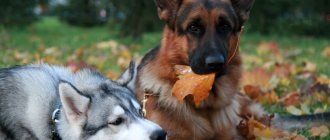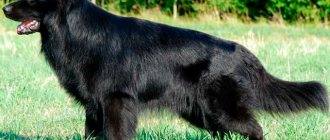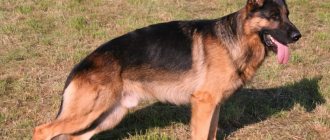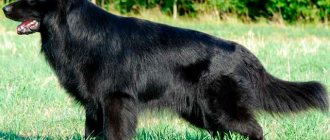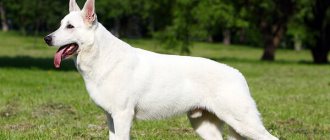German Shepherds are the most popular dog. For many centuries she has lived next to a person, protecting him and helping him. This is a service breed, but it is difficult to find another dog as loyal and intelligent. They call it universal because you can teach it anything: shepherd dogs work in the police, the Ministry of Emergency Situations, act in films, guard the house. This is a devoted friend and protector, kind to children, unpretentious. But proper upbringing is necessary, it is important to create the necessary conditions for the pet’s life. Therefore, before choosing a German Shepherd puppy, you need to study the pros and cons.
- Standards
- How to train
- Hygiene
Breed traits
Breed traits (on a 5-point scale)
| German Shepherd | |||
| Activity | in the house | 2.8 | |
| on the street | 4.3 | ||
| Obedience | training | 4.3 | |
| strangers | 4.4 | ||
| Domination | in family | 2.7 | |
| over dogs | 3.8 | ||
| Defending your territory | from people | 3.5 | |
| from dogs | 4.1 | ||
| Sociability | in family | 4.6 | |
| with strangers | 2.7 | ||
| with dogs | 2.9 | ||
| Concentration | in family | 1.7 | |
| in front of strangers | 3.1 | ||
| with dogs | 2.5 | ||
| Aggressiveness | in family | 1.6 | |
| to strangers | 3.2 | ||
| to the dogs | 3.3 | ||
| to cats | 3 | ||
| Family behavior | calmness | 4.4 | |
| demand for affection | 4.2 | ||
| excitability | 3.7 | ||
| playfulness | 4 | ||
| excessive barking | 2.5 | ||
| behavioral breakdowns | 2.3 | ||
| Tolerance for children | up to 4 years | 3.5 | |
| over 4 years old | 3.9 | ||
| Institutional use | watchman | 4.7 | |
| bodyguard | 3.9 | ||
This breed is often compared to the following dog breeds: Labrador Retriever, Rottweiler, Doberman Pinscher, Cane Corso, Belgian Malinois.
General characteristics of German Shepherds
German Shepherds are unique dogs. Their main characteristics are amazing performance, versatility and adaptation to humans. But for this dog to truly become a friend and protector, you need proper training, sufficient care, and most importantly, give him a lot of attention and love.
German Shepherd
The purebred German Shepherd is not very large, but hardy and agile. In terms of height and weight, it belongs to large breeds, although some females weigh a little more than 20 kg. Life expectancy is 10-13 years. These are flexible, loyal pets. They are smart and recognize the authority of their owner.
pros
German Shepherds have long occupied first place in ratings of the most intelligent, efficient and loyal dogs. Judging by reviews from breeders, they are also popular because of their appearance. This breed has many positive qualities and advantages over others.
- Stable psyche, lack of aggressiveness, great sensitivity. They understand the owner’s mood and can predict his desires. This makes the Germans the best guides and bodyguards.
- High intelligence and learning ability allow them to be used for any job. These shepherd dogs can guard a room, protect, search for drugs or explosives, and save people. This is a versatile service dog.
- These are calm, playful, affectionate pets. They are not conflicting, not aggressive. They are kind to children, protect them, and get along well with other pets.
- They are unpretentious and picky, quickly adapting to home conditions. They can live outside even in winter and get used to being kept in an apartment. They don’t create any problems with nutrition either—they eat everything they’re given.
- They are sociable, loyal, and unforgiving. They get used to one owner and have a hard time parting with him.
- Unlike many other breeds, the German is beautiful, elegant, agile and hardy.
Minuses
But German Shepherds, like any other breed, have disadvantages. Much depends on the owner, so this dog is not suitable for everyone. The disadvantages of the breed include:
- due to its size, a lot of space is required; a German will feel uncomfortable in a small apartment in the city;
- strict education is necessary, it is important to show patience and perseverance;
- a general training course is required, preferably under the guidance of an experienced dog handler;
- they can be stubborn;
- long walks are important; in the absence of sufficient physical activity, they grow uncontrollable;
- they are loyal to one owner, they can show aggression towards people around them and even bite;
- This pet will produce a lot of hair, especially during shedding, and you can also smell the dog.
You can watch a video about the pros and cons of the breed.
Video: German Shepherd. Pros and cons of the breed
Varieties
Now there are several types of German Shepherds. The wide popularity of the breed has led to breeders in different countries developing new varieties. Several lines have become widespread, with slight differences between them:
- the purebred german or classic line of the breed is distinguished by loyalty and goodwill towards people;
- German Shepherd working dog is used for police work;
- Eastern - these are calm dogs with a strong build;
- the English one was bred for military purposes;
- American are shepherd dogs with a soft, kind character and an angular build;
- The difference between the Czech line is that they are very hardy.
Mixed breeds or crosses of German Shepherds with other breeds are usually friendly and intelligent, but lose their service qualities. They are crossed with other shepherd dogs, Alabai, Rottweilers and even with a wolf. It is difficult to say which type of German Shepherd is better. It depends on the purpose for which you are getting a pet. And to understand what the difference is, you need to look at photographs of different types.
Black German Shepherd
German Shepherd
Interesting Facts
German Shepherds are unique working dogs. There are many interesting facts associated with them.
- These dogs saved many people and helped during the war. They carried cartridges, carried the wounded from the battlefield, and worked as sappers. Often they died and even sacrificed themselves. There is evidence that more than 60 thousand German shepherds served at the front during World War II.
- They can reach enormous speeds - up to 50 km/h, and are very maneuverable in their movements. They do not stumble and can turn and brake sharply.
- They have powerful jaws. The clamping force is up to 100 kg/cm2.
- Thanks to their attractive appearance, they often appear in films, participate in TV shows, and various competitions.
- German Shepherds are the first breed to be used as guide dogs. They are not only obedient and calm, but they are well oriented even in unfamiliar areas.
- There are three monuments in the world dedicated to this breed.
- The price of a purebred German Shepherd can reach $900.
The main characteristics of this dog can be found in the table:
| Options | Characteristic |
| Temperament | Kind, loyal, calm, moderate aggressiveness |
| Activity | Very agile, resilient, fast, needs a lot of physical activity |
| Training | Very easy, can be taught any commands, suitable as a guide dog |
| Intelligence | Tall, have intuition |
| Wool | Sheds heavily twice a year and has a dog smell |
| Care | Unpretentious, does not require special conditions of detention |
| Health | Average life expectancy – 9-14 years |
Where is the best place to keep it?
Veterinarians and dog handlers are unanimous in the opinion that the ideal conditions for a shepherd dog are a spacious enclosure with an insulated booth .
This does not mean that a dog cannot be kept in an apartment. If you follow a walking regime and regular street training, the dog will feel no less great.
History of the breed
The country of origin of German shepherds is Germany; these dogs were previously used there as herding dogs and guard dogs. That's why they got this name. According to the official version, the breed was bred on the basis of South German herding dogs. In ancient times they descended from wolves or wild dogs. This is the first breed that was domesticated by humans several thousand years BC. e.
In the Middle Ages they were used in Europe as shepherds, property guards, and security guards. They protected sheep and owners from wild animals and robbers. Therefore, the largest, hardiest individuals were selected, as well as those that could become a devoted friend and companion. By the 18th century, two types were bred: short-haired, active, gray-fawn in color and long-haired, black and red, calmer and hardier.
Longhaired German Shepherd
At the end of the 19th century, a new breed was presented at the Hanover Exhibition. The German Shepherd quickly became popular and spread throughout the world. The selection was carried out by Max von Stefanitz. He paid a lot of attention to the working qualities and intelligence of dogs. They were used as service dogs, so the main requirements were endurance, ability to control, and obedience. They quickly replaced Dobermans and Rottweilers in the police force. But by the beginning of the Second World War, breeding of the breed ceased, many nurseries were destroyed.
The breed appeared in Russia at the beginning of the 20th century. At first they were brought to serve in the police. But gradually the breed became popular. At the end of the 60s of the 20th century, the International Association was created, uniting German shepherd lovers from 82 countries.
Pros and cons of service Germans
German Shepherds of working breeding have their advantages and disadvantages.
The advantages include:
- high performance, endurance, physical capabilities;
- mental stability;
- unpretentiousness in care, maintenance, feeding.
Minuses:
- less impressive appearance than show-class dogs;
- if raised incorrectly, they can grow up aggressive and uncontrollable;
- not suitable as companions;
- The dog needs active work and constant stress.
Description of the exterior of the German Shepherd
German shepherds belong to large working breeds, but these dogs weigh no more than 40 kg, and their height reaches 60 cm. Therefore, they are sometimes classified as medium breeds. They have distinct differences between males and females: the former are larger and have strong bones. But all representatives of the breed have powerful muscles and a proportional physique. This is clearly noticeable in any photograph.
Standards
The modern breed standard was adopted in 1996. The description of the shepherds has not changed much, but some minor amendments have been made. The weight of a male German Shepherd should be 30-40 kg. Deviations of more than 1 kg are not allowed. Females weigh less - from 22 to 32 kg. The height at the withers of a male German Shepherd is 60-65 cm, the height of a female is 55-60 cm.
Head
The head is large, but proportional to the body. The proportions between the muzzle and the skull are 1:1. The shape is wedge-shaped, not very wide. The nose is level, with a slight smooth stop. The lobe is large, always black. The jaws are powerful, with a scissor bite. Lips fit tightly.
The ears are pointed, triangular, set high. They are large, mobile, open forward. They are usually erect, but in the long-haired variety they are semi-hanging. The eyes are deep, brown in color, widely and slightly slanted. The look is smart and attentive.
Torso
The German Shepherd is a dog with a strong build and powerful, toned muscles. The neck is smooth and muscular, the chest is massive and deep. The line of the back decreases towards the croup. The back is wide and strong. This is clearly noticeable in the profile photo of the dog.
The tail is long, set low, and saber-shaped. When the dog is calm, it is lowered, but the tip is usually curved upward. Even in short-haired varieties it is fluffy.
Limbs
The forelimbs are straight, set parallel. Elbows are pressed. The hind legs are slightly set back, the lower leg and thigh are of equal length. The paws are round and compact. They spring well when moving.
Wool
The German Shepherd has a thick, coarse coat with a dense undercoat. More dense fur on the neck, paws and tail. There are two types of the breed: short-haired and long-haired. The first is the classic variety; in Germany only such dogs are recognized. They have thick fur that does not puff up, but fits tightly.
The difference between long-haired shepherd dogs is that they have soft hair and an equally dense undercoat, but they tolerate cold worse than short-haired dogs. The undercoat is also dense and dense. Feathers and a bushy tail appear on the ears and paws. They are rarely used as service dogs, as they have a more nervous character.
Color
German Shepherds can come in several colors. There are three recognized standards: gray-black, yellow-black and pure black. Among them there are many types.
- The most common color is called saddle cloth. Black-backed dogs seem to have a black mantle on their back. It covers the back, the upper part of the tail. A black mask is required on the face. The underparts of black-backed dogs are usually red or fawn, but can be grey, chocolate or off-white.
- Black German Shepherds are rare, only 5%. This color is rich, without splashes of white or other colors.
- The zonal color may have a gray or red tint. It is similar to the saddleback, but less black - only darkening on the back and face.
Having looked at the photographs, you can understand what color a proper shepherd dog should have, since it is difficult to imagine from the description.
German Shepherd, shabby color
Black German Shepherd
Zone color
Deviations from the standard
Any deviations from the standard are considered deficiencies. Such dogs are not allowed for breeding and participation in exhibitions. There are several most common faults that a proper German Shepherd should not have:
- white color, common only in America;
- completely red or gray color is not recognized at all;
- inclusions of other colors in black dogs;
- short stature - the dwarf German shepherd is not officially recognized, although there are many fans of this variety in the world;
- deviations from height and weight standards;
- low set ears;
- not a scissor bite;
- long soft wool.
Physical activity
German Shepherds are large dogs that have a well-balanced, muscular body structure. They create an external impression of considerable strength and dexterity. “Germans” have large, pointed ears, erect ears, a bushy tail, strong jaws and a powerful bite. The expression on the German Shepherd's face is the complete simultaneous personification of trust and vigilance.
When moving, dogs have a long stride, which allows them to cover long distances very quickly. The color scheme of the coat of this breed is most often dominated by black and brown colors. But there are many combinations and predominances of them, which makes the breed externally diverse. There are also plain, even pure black representatives.
Return to content
Character of dogs of this breed
The German Shepherd has a calm, reserved temperament. Her character is flexible, friendly, and non-conflicting. Aggression is shown only in extreme cases. Most photos on the Internet show how these pets love their owners and care for children. They will tolerate many pranks; the pet will never show aggression towards a child. They are tolerant of other animals, especially if they grow up together.
High guard qualities and developed intelligence allow the dog to assess the threat to the life and property of the owner and even make independent decisions. He has a well-developed protective instinct; she can even sacrifice herself to save any family member. There is no cowardice or cowardice among the Germans. They are brave, loyal, hardworking.
This dog cannot be punished or humiliated. This will cause psychological trauma to the pet and may cause mistrust in the owner. For an offense you need to scold, the Germans are able to realize their guilt. Dogs of this breed do not like to be alone. For a normal psychological state, they need communication with a person. Therefore, this breed is not suitable for those who work all day or are often away. The Germans have a connection with their beloved owner on a psychological level; they feel the person’s mood.
How to train
The German Shepherd does not immediately become smart and obedient. She definitely needs to be raised properly. These dogs are easy to train and quickly understand basic commands. But training of German Shepherd babies begins from the first days of their appearance in the house - from about 2 months of age. Without training, an uncontrollable, aggressive dog can grow up, causing problems for its owners and everyone around them. It will be difficult to retrain an adult German Shepherd later.
Sit command
Working with German Shepherd puppies is necessary in a playful way so that the kids find it interesting. These pets are pliable, intelligent and obedient, so training will not bring any problems. The main thing is to be consistent and patient. It is mandatory to teach the commands “Come to me”, “Sit”, “Lie down”, “Place”, “Fu”, “No”, “Near”, “Walk”. On the street it is necessary to accustom him to a leash and muzzle. To encourage during the training process, you need to use affection, praise or treats. It is very important to gain authority from the very beginning with your pet.
Even if the pet will not be shown, it is advisable to take a handling course with a professional trainer. He will teach the shepherd the correct stance with one hind leg extended back. It is also worth contacting the services of training professionals if the pet will guard the house or babysit children, as well as if behavioral problems arise.
You can watch a video about mistakes in training shepherds.
Video: German Shepherd. Training mistakes
Does he get along with other pets and children?
The German Shepherd (especially if it is a female) is very careful with children - it patiently tolerates it when children pull its tail or hug it, makes sure that the child does not accidentally harm itself, and if the baby behaves too aggressively, it simply goes into another room .
CAREFULLY!
Males, especially adolescents, can become overexcited during active ball games and jump on the child, so it is better to carefully monitor such interactions.
As for other animals, the German Shepherd remains neutral. Males, again, may show dominance tendencies.
Caring for a German Shepherd
The German Shepherd is unpretentious and can adapt to any conditions. She lives well in an enclosure or house. Due to its size, this dog cannot be kept in a small apartment; it needs space. When kept this way, the puppy can destroy and chew everything it can reach. He will develop worse, especially if left alone. Therefore, a pet who lives in the city must be taken outside at least 2 times a day. Walk for at least an hour, move a lot.
A German Shepherd can live in the yard even in winter. Even if the animal has a spacious enclosure, it is recommended that he make a booth in which he can hide. For an example of what it should be, you can look at photos on the Internet. But in winter, during frosts, it is better to let the dog into the house. It is advisable not to tie your pet; he should run freely around the yard to splash out his energy.
Hygiene
Hygienic care for representatives of this breed is simple. You need to examine your eyes and ears every day and, if necessary, clean them with special products. It is not advisable to bathe more often than once every 2 months, so as not to wash off the protective lubricant. But after a walk, especially in winter and in rainy weather in the city, the dog needs to wash its paws and belly.
It is recommended to comb the coat with a special brush 2-3 times a week. Only during shedding and long-haired dogs daily.
You can watch a video about caring for a shepherd.
Health
Shepherd dogs are in good health; if you are vaccinated and prevented against worms, your pet will not get sick. But there are several pathologies that are common in dogs of this breed:
- sensitive digestion;
- allergic diseases;
- joint dysplasia;
- otitis.
Shepherd dogs are very sensitive to infections, so it is important to visit a doctor on time and get all the necessary vaccinations. It is especially important to vaccinate your pet against common canine diseases.
Feeding
You can feed your pet both commercial food and homemade food. A German Shepherd's diet must contain at least 40-50% meat. The rest consists of cereals, vegetables and fruits, and fermented milk products. What foods should you include in your diet:
- beef, turkey, chicken, rabbit;
- only the heart and stomach are by-products;
- eggs 1-2 times a week;
- lean fish;
- cottage cheese;
- The best cereals are rice, oats, buckwheat;
- cabbage, zucchini, pumpkin, carrots.
Neither puppies nor adult dogs should be given bones, fatty meat, sausages, pasta, baked goods, semolina, corn, nuts, raisins, sweets, especially chocolate. When preparing food for your pet, do not use sugar, salt or spices. This will help avoid weight gain and other problems. It is especially important to carefully prepare a diet for pregnant bitches and small puppies. A properly chosen home menu will help your dog grow healthy and live longer.
If dry food will be used to feed the dog, you need to choose only super-premium or holistic types. Good food contains all the necessary vitamins and minerals, the composition is balanced in the amount of proteins, fats and carbohydrates. You just need to choose it according to the age and size of the pet.
It is also important to figure out how much food to give your pet. For a puppy up to 2 months, 1 glass of food per day is enough, from 2 to 3 - 2 glasses, from 3 to 6 its amount increases to 1 liter, from 6 to 12 months - to 1.5 liters. You should also find out from the breeder or veterinarian how many feedings should be per day. After a one-month-old puppy switches from breast milk to regular food, he is fed 5-6 times until he is 3 months old. Up to six months, a puppy needs 4 times, and from 6 to 12 months – 3 times. After a year, the pet needs to be fed like an adult dog - twice a day.
average life expectancy
The average lifespan of a dog of this breed is from 10 to 15 years.
NOTE!
The better the living conditions for a dog, the longer the pet maintains a cheerful state of mind and physical strength.
Selection of German Shepherd puppies
Having decided to buy a dog of this breed, you need to weigh everything, find out about the pros and cons, and decide on the gender. It is recommended to communicate with experienced dog breeders, visit exhibitions, kennels, observe dogs, study information about them and photographs. After choosing a breeder who offers purebred purebred shepherd dogs, you need to visit him, find out how much it will cost, get acquainted with the living conditions, find out how the bitch gave birth, what her diet was.
German Shepherd puppy
German Shepherd puppy
Teenage German Shepherd
Puppies are usually purchased at 2 months of age. By this time they have received basic vaccinations. But vaccination continues for several months, so be sure to visit a veterinarian. The cost of a purebred shepherd dog in Moscow ranges from 25 to 60 thousand rubles. A pet without documents can be bought for 10 thousand.
An interesting video about the German Shepherd will help you make your choice.
Video: German Shepherd - Interesting facts about the breed
The German Shepherd has long been popular not only among professional breeders, but also among ordinary dog breeders. This is not only a guard and protector, but a devoted friend, companion and nanny for a child. If you raise your pet correctly, it will bring only joy.
How to choose?
German Shepherd puppies are very cute and it is difficult to cope with emotions when choosing a four-legged friend according to the rules, and not the dictates of the heart.
- First of all, you should decide why you are purchasing a dog. Some people decide that they need a purebred individual with whom they will attend exhibitions and breed, but then abandon this idea. As a result, shepherd dogs with excellent pedigree and good conformation live their entire lives in an enclosure, although they could bring a lot of benefit.
- Some people, on the contrary, want to make a friend, but after the purchase they become interested in exhibitions. However, if the pet was chosen for the soul, it may not meet the requirements of the exterior and may not be suitable for participation in exhibitions. For this reason, you should make your decision in advance to avoid disappointment.
- For exhibitions, it is not enough to buy a puppy from a kennel with a good pedigree; you should study the history of breeding “Germans” and become familiar with profitable breed lines. Each nursery has its own characteristics that you need to get to know. In Russia there are a large number of kennels where German shepherds are bred. They are found in different parts of the country, including in Altai and Siberia.
- Also, when choosing a puppy, you should familiarize yourself with the breeding laws, according to which shepherd dogs were required to undergo testing. The tests included kerung, which is a selection method. The nervous system is studied along with conformation and performance characteristics. You can ask the breeder for the results of this test in order to know information about the parents of the future puppy.
- Choosing a purebred dog is not an easy task. However, if you take a puppy without documents, you may encounter defects in standard, temperament, and the animal may also have hereditary diseases.
- It is best to choose a pet between one and a half to three months old. The puppy will have time to grow up and will be able to quickly get used to the new environment. It is not recommended to purchase an adult animal, as there may be problems with addiction.




